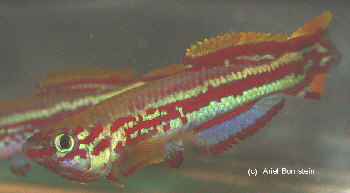
Fundulopanchax kamdemi
Christian Akum, Rainer Sonnenberg, Jouke R. van der Zee &
Rudolf H. Wildekamp 2007.

Photo courtesy of Ariel Bornstein
| Meaning of Name |
After Andre Kamdem Toham of the World Wildlife Fund’s Central African Rainforest Project (CARPE) who collected & studied endemic Killifish in the Korup National Park. |
||
| First Description |
Fundulopanchax kamdemi (Cyprinodontiformes: Nothobranchiidae) a new species from Korup National Park, western Cameroon. Christian Akum, Rainer Sonnenberg, Jouke R. van der Zee & Rudolf H. Wildekamp 2007. Zootaxa 1532: 41–49 (2007) |
||
| Size |
50 mm - male (holotype). The paper containing the first description gives maximum sizes in Paratypes as - males 73 mm, females 61·7 mm. All sizes Standard Length (SL). |
||
| Meristics | D= 15-18, A= 16-19, ll= 34-38 +3-4 on caudal fin base. | ||
| Karyotype | |||
| Sub-Genus |
|
||
| Group |
|
||
| Synonyms |
|
||
| Populations |
|
||
| Type Locality |
Korup National Park: west of science camp |
||
| Distribution |
Limited distribution area in the Akpa-Yafe River
drainages and the upper Ndian River, in southern Korup only. |
||
| Habitat |
Small swampy pools and rivulets of the Ndian
and Akpa-Yafe River systems, Cameroon. |
||
| Distinguishing Characteristics | Two
wide red bands running horizontally through males. This is also seen in
some populations of Fp.puerzli from
Dibamba, Cameroon. Anal fin patterning is 'unique'. This sp. has a high
number of rays in dorsal & anal fins. Females have an orange-red margin at the dorsal fin and a narrow red band at the base of the anal fin. |
||
| Colour/Pattern Variability | Low. | ||
| History |
Collected by A. Kamdem Toham, 19 December 1992
Korup National Park: west of science camp;. These were used as Paratypes.
|
||
| Breeding Notes |
Reportedly not easy to breed. The original wild
fish from 2001 were given to a competent breeder who managed to raise
some fish. A dry storage period of 8 weeks was reported but this time
was cut down to 4 weeks by putting eggs on damp/wet peat. After this
period cool, fresh water was added. Reports have suggested in 2008 that males are predominant in sexing out & some work needs to be done in this area. I saw on an AKA forum Lacorte used #3 gravel as a spawning medium. A net was swirled above the gravel to collect eggs. |
||
| Diameter of Egg | |||
| Remarks |
Although it's 16 years on (2008) since first
introduction this sp. has not been as widely distributed as its close
cousin - Fp.amieti.I feel sure the
problem can be cracked & this sp. can be more available. Reference links - |